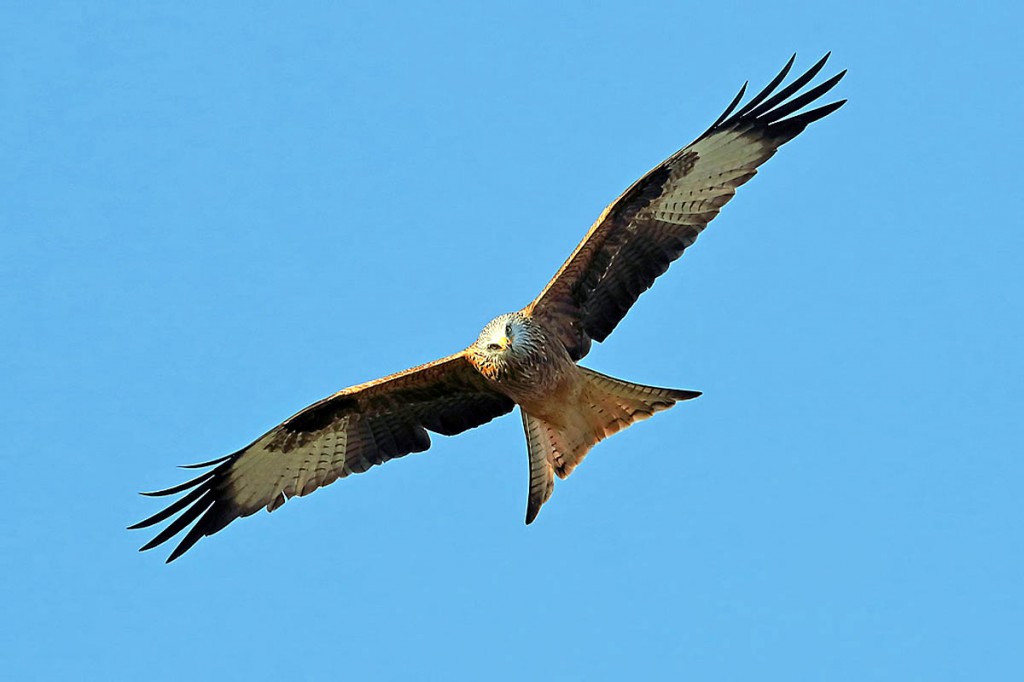
Red kites have been successfully reintroduced to areas of Britain. Photo: Walter Baxter CC-BY-SA-2.0
A red kite whose body was found at a raptor-persecution blackspot had survived being shot twice, only to be killed by pesticide abuse.
North Yorkshire Police said investigations on the dead bird of prey found in Nidderdale showed traces of two banned pesticides.
A landowner found the body of the red kite at the end of October last year and contacted police, fearing criminal activity might have taken place on his land.
A police spokesperson said: “North Yorkshire Police arranged for the bird to be x-rayed, and this showed there were two pieces of shot in the bird. However, it was not possible to say whether these had caused fatal injuries.
“Police released details of the incident, and appealed for information from the public.
“Officers have now completed their enquiries. The dead bird was subjected to a post-mortem [examination], which concluded that the injury caused by one piece of shot was old and had healed. The damage caused by the second piece was recent but was not a fatal injury.
“The bird was then submitted to the wildlife incident investigation scheme, which is administered by Natural England. It was subjected to toxicological tests which found several poisons in the bird.
“The largest quantity of poison was a substance called bendiocarb, a pesticide which is licenced for use in the UK. Smaller amounts of two other pesticides, isofenphos and carbofuran, which are both illegal in the UK, were also present. The report concluded that the kite had died as a result of the abuse of several pesticides.”
Police said no suspects had been identified. Anyone who has information that may help them is asked to contact North Yorkshire Police, quoting reference 12180199938.
The spokesperson said: “The test results suggest that someone not only has access to two illegal poisons, but is also placing them, along with a legal pesticide, into the environment so that a wild bird has been able to consume them.
“In addition to being poisoned, the bird had also been shot at least twice during its life.”
Red kites have been successfully reintroduced to Yorkshire, having been extinct as a breeding bird in England, and they are now a familiar sight to people in Nidderdale.
All birds are protected by law and it is a crime to intentionally kill, injure, or take any wild bird. If anybody has information about persecution of birds of prey, whether by poisoning or shooting, they are asked to contact police on 101.
The spokesperson added: “Anyone misusing pesticides may also be committing a variety of offences. If you come across an object which you believe may be contaminated with a pesticide or other poisons, please do not handle it.
“Report the situation immediately to the police giving accurate details of location and why you suspect involvement of a poison.”
Wainwrightwalker
10 August 2019Why?
Seriously, why?
Red kite diet = small mammals (voles, mice, etc..), carrion and the OCCASIONAL game bird.
What do the people who shot this and poisoned it think they eat?
The world has google, these criminals don’t have the wherewithal to use google, and they have guns...
All the police have to do is find the phone signal black spot and lack of internet and arrest the gun owner.
Peter Owens
11 August 2019It's good to see that it was a landowner who reported the dead bird.
The real culprits are those who employ the people who do the killing of wildlife. To be charitable, with employment hard to come by in places like Nidderdale, you can see that staff will do whatever they think it takes to keep their job - all deniable as far as the employer is concerned, of course.
There are several things that can be done:
Bring grouse shooting under proper control by making it subject to licensing;
Make the employers criminally liable, not just their staff, as is the case in Scotland;
Make subsidy payments conditional on stringent requirements in relation to pesticide use and stop them permanently if there is evidence of wildlife persecution in any form.
Mike Haden
14 August 2019Employment Hard to come by? yes in areas where driven grouse shooting has it's hold, but what about similar places like the Lake District. If there was a change of land use, and people were made to feed welcome, and environment was allowed back to its' natural state.then the economies of these areas would flourish. The Red Kite trail in Southern Scotland is world tens of £millions to the local economy.
It's just that the landowners want to keep their large subsidies and keep people out, so that their employees can carry on with their criminal activities.
Peter Owens
14 August 2019Yes Mike, what you say is exactly right.
It's interesting that some large estates in the Highlands, for example Mar Lodge (which is NTS owned), Glen Feshie and Gaick, are moving to walk-up grouse-shooting, rather than driven shooting - see: https://www.theguardian.com/uk-news/2019/aug/11/highland-estates-swap-driven-for-walked-up-grouse-shooting. It's a first small step in roughly the right direction, at least.
However, as you indicate, the underlying problem is the ownership and use of land and the dead hand that these businesses apply to the local communities, economy and environment, just for their own profit.
Part of the problem, in Scotland especially, is the sheer size of the estates, making it difficult for anyone without large financial resources to buy the land. It's well beyond the reach of local communities and even fair-sized charities.
We may not be able to change much, but at least we can keep up pressure for change by supporting organisations such as the John Muir Trust, NTS and RSPB, and those who are campaigning for changes in legislation to get these businesses under some control.